1. Introduction
Courtly life under King François Ier (1494–1547) offered the French nobility ample opportunity to transform itself by means of extraordinary costumes and roleplaying. Masked manifestations such as mommeries, a form of masquerade that typically interrupted a ball and in which costumed participants presented themselves before their audience to dance and mime, provided pleasure and a fleeting escape from reality.Footnote 1 At the same time, however, these events could also serve to highlight the court’s structure and to translate into striking visual terms the ambitions and personalities of those who partook in them. Judging from the plethora of extant diplomatic reports offering detailed descriptions of sumptuous costumed festivities organized by the king and his entourage, these modes of entertainment played an important role in furthering the French court’s international reputation for sophistication and wealth.
As contemporary accounts and extant costume designs by court artists reveal, the characters and allegorical concepts that were brought to life in these performances were plucked from the literary and artistic culture that flourished in this period and owed a heavy debt to the classical world.Footnote 2 While costumes and props shared much in common conceptually and aesthetically with royally commissioned art and architecture, they were the centerpieces of ephemeral events and thus bore the burden of making an impression striking enough to last long after the pipe-playing had ceased. As a result, the creations invented for masquerades frequently veered from the whimsical to the bizarre, often bewildering audiences accustomed to Mannerist flights of fancy. In addition to pagan gods and biblical heroes, masquerades featured extraordinary beasts, exotic foreigners, and even living objects, including a walking perfume dispenser.Footnote 3
A comprehensive critical history of the iconography of masquerading in Renaissance France has yet to be written. Margaret McGowan’s latest book constitutes an invaluable source of historical information on sixteenth-century French costumed events, but in exploring this topic, the author’s primary focus is dance.Footnote 4 In a recent article, however, McGowan concentrates more specifically on the richness, variety, and eccentricity of the costumes fashioned for French festivities in this period.Footnote 5 A wealth of new documentary evidence concerning masquerades at the courts of François Ier and Henri II (1519–59) has also become accessible, thanks in part to the efforts of Carmelo Occhipinti, who in recent years has published a substantial body of Italian diplomatic correspondence.Footnote 6 Both Occhipinti and Dominique Cordellier have succeeded in connecting several extant preparatory drawings to costumes that were described by ambassadors who encountered them at festivities, thereby shedding new light on these events, their designers, and their participants.Footnote 7
This study examines ancient Egypt as a source of inspiration in masquerades sponsored under François Ier. More specifically, it considers how references to this exotic ancient culture that prized secrecy were symptomatic of a broader French Renaissance fascination, especially nurtured by François, with concealed truths and guessing games. The investigation opens with a discussion of a polymastic sphinx costume (fig. 1)Footnote 8 worn by the king and Cardinal Jean de Lorraine (1498–1550)Footnote 9 at a nuptial celebration in early 1546. The costume was designed by Francesco Primaticcio (1504/05–1570), whom François invited to France in 1532 and who, as a court artist, had frequent occasion to participate in the creation of ephemera during his lengthy French career. Evidence of France’s interest in Egypt in this period is considered first, followed by an analysis and interpretation of the costume’s appearance. Possible sources for its iconography are proposed and the significance of its having been worn by both the king and the cardinal is assessed. Attention is then focused on two other costume studies by Primaticcio (figs. 2–3), which, as this article shows, were derived from hieroglyphs in the first French edition of Horapollo’s famed fifth-century interpretative guide to Egyptian image-symbols, the Hieroglyphica.Footnote 10 Constituting veiled messages in sartorial form, these kinds of costumes were meant to be deciphered and to spark discussion, and as such, to both elevate and demonstrate the French court’s sophistication.
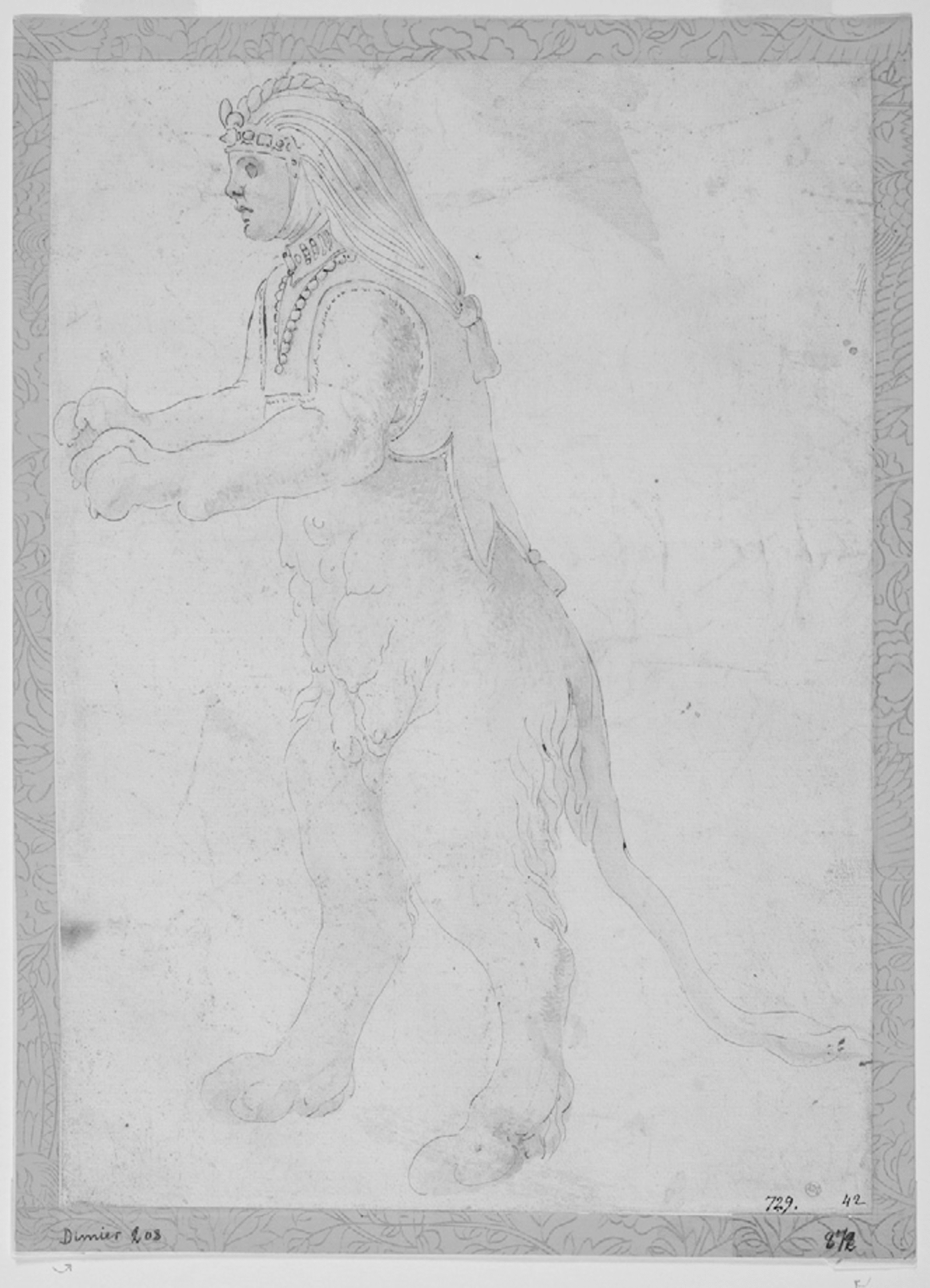
Figure 1. Francesco Primaticcio. Study for a Polymastic Sphinx Costume, ca. 1545. Pen and brown ink, gray wash, and watercolor. Stockholm, Nationalmuseum (872/1863). © Nationalmuseum, Stockholm.
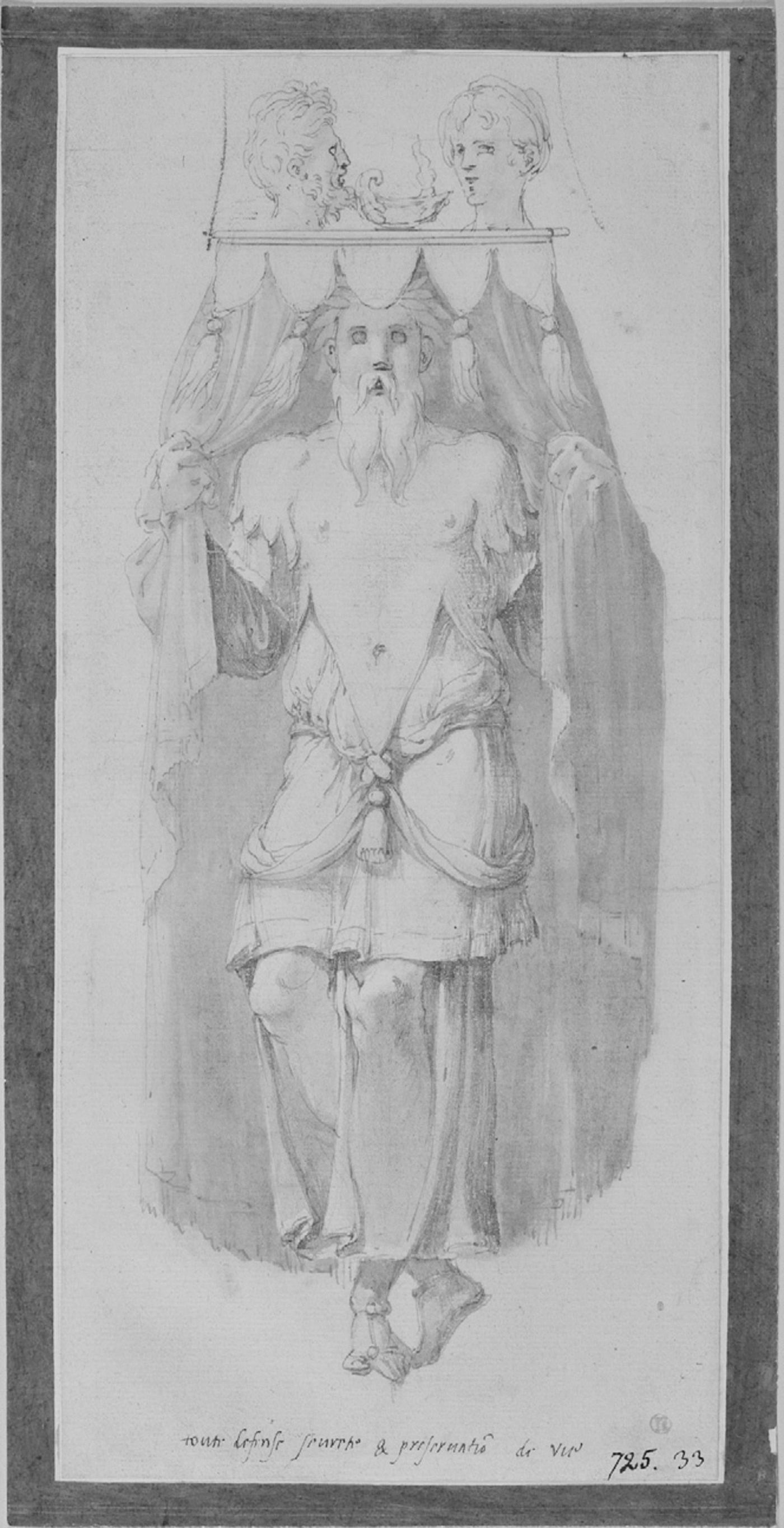
Figure 2. Francesco Primaticcio. Study for a Hieroglyphic Costume: The Defense and Preservation of Life, ca. 1543–47. Pen and grayish-brown ink, watercolor, and black chalk. Stockholm, Nationalmuseum (868/1863). © Nationalmuseum, Stockholm.
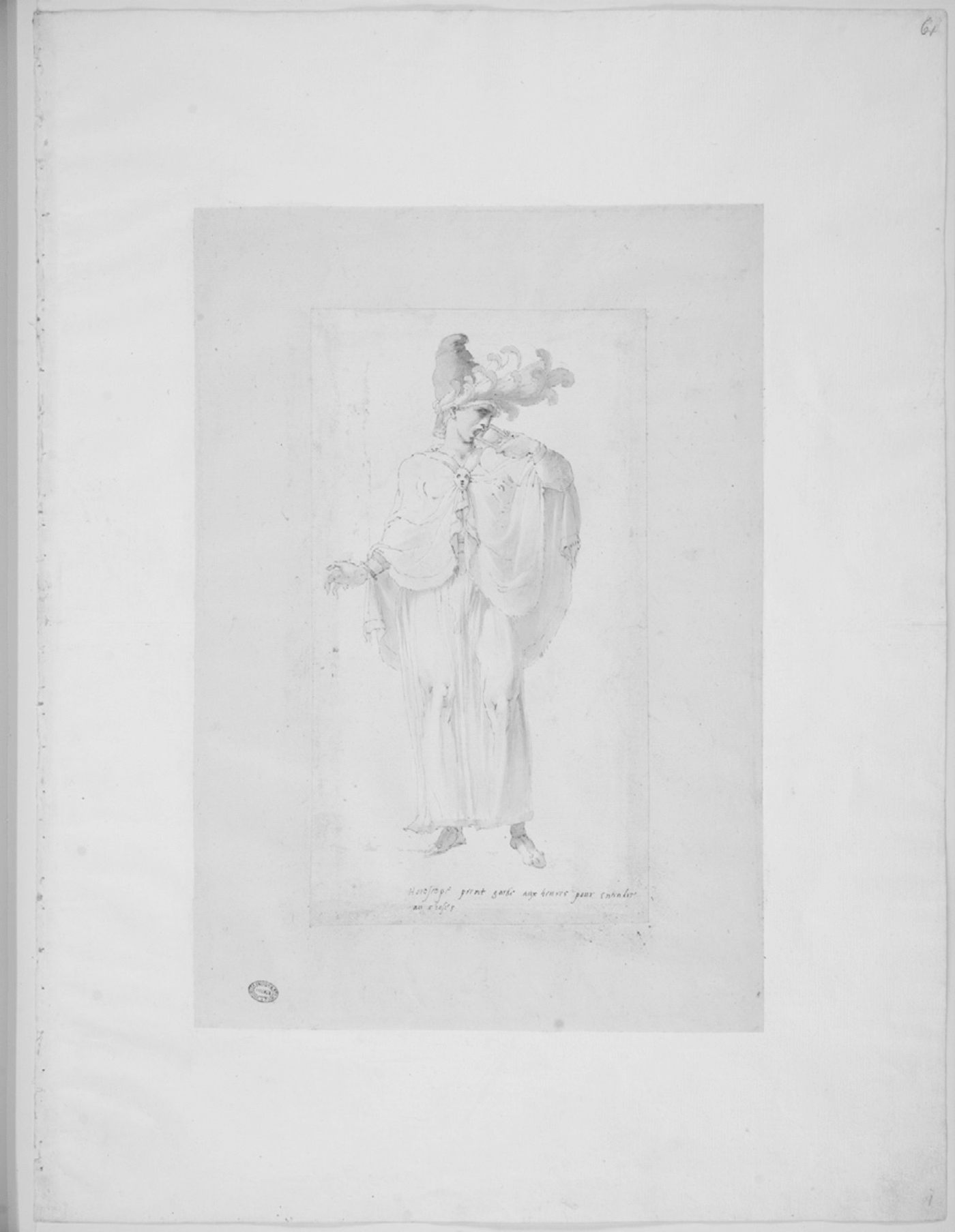
Figure 3. Francesco Primaticcio. Study for a Horoscopist Costume, ca. 1543–47. Pen and brown ink, watercolor, black chalk. Biblioteca Nazionale Centrale di Firenze (MS Palat. C.B 3 53/2, fol. 61). Permission from the Ministero per i beni e le attività culturali della Republica Italiana / Biblioteca Nazionale Centrale di Firenze.
2. Tails for a Wedding Celebration
Costumed performances were a staple of the festivities accompanying important diplomatic meetings, as well as rites of passage, such as baptisms and marriages. Of course, these were political events in their own right: the creation of heirs and the formation of new alliances through matrimony were essential to demonstrating the strength and permanence of the powers that were. Like those related to births or a particular political event, masquerades organized in honor of marriages (which generally took place during the Carnival period) could feature a wide range of characters.Footnote 11 In some instances, the connection to the theme of matrimony was made explicit, as in the case of the Hymenaeus costume designed by Primaticcio (fig. 4) and described by the Ferrarese ambassador Lodovico da Thiene in a letter to Ercole II d’Este (1508–59) dated 25 February 1542.Footnote 12 Lodovico had occasion to see the outfit when it was worn by the Dauphin Henri and his companions at a masquerade held in honor of the Parisian wedding of Jeanne de Vivonne de la Châtaigneraie and Claude de Clermont, Baron of Dampierre. In addition to carrying the god of marriage’s traditional attribute of flaming torches, the future King of France and his friends each sported golden hair, an elaborate helmet featuring a nature goddess as well as a Cupid satiating his thirst, and a red-and-gold tunic topped by a white drapery, which the Italian observer remarked was meant to symbolize the hymen from which the deity derives his name.Footnote 13 Lodovico also indicated that the torches they carried were wrapped in garlands and exuded a sweet perfume, calling to mind Ovid’s description of the wedding of Perseus and Andromeda, when “Love and Hymen shake their marriage torches, and fires are fed by incense in abundance, and garlands wreath the roofs.”Footnote 14
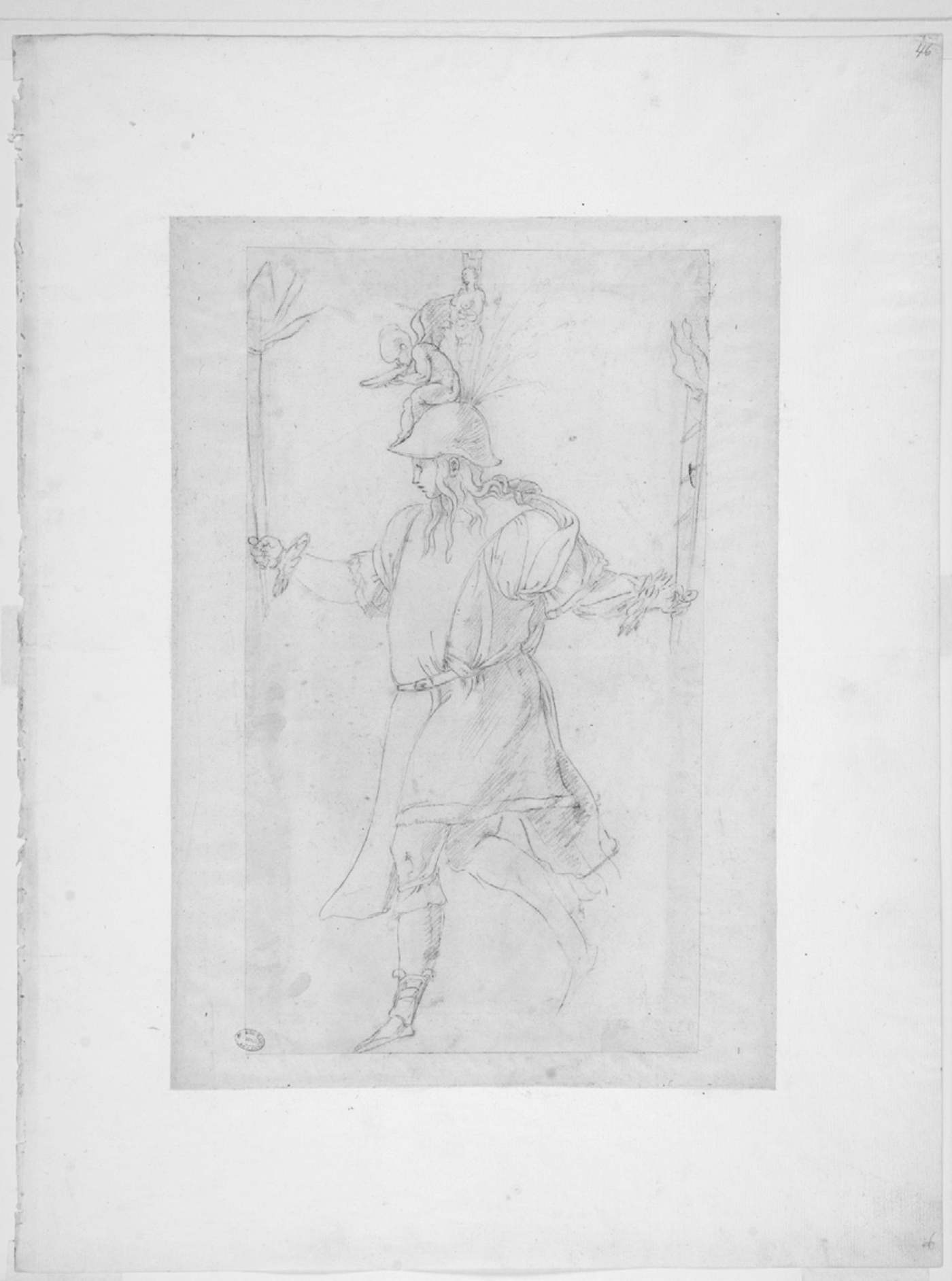
Figure 4. Francesco Primaticcio. Study for a Costume of Hymaneaus, ca. 1541–42. Black chalk and stylus. Biblioteca Nazionale Centrale di Firenze (Palat. C. B. 3. 53, II, c. 46). Permission from the Ministero per i beni e le attività culturali della Republica Italiana / Biblioteca Nazionale Centrale di Firenze.
A costume for a wedding-related masquerade could thus overtly evoke the themes of love and marital union; in other instances, the correlation between the costumes worn and the nature of the festivity is less obvious. Such is the case with Primaticcio’s design for a polymastic sphinx costume (fig.1).Footnote 15 The drawing closely corresponds, as Cordellier observes, to a description in a letter published by Occhipinti that was addressed to Ercole II d’Este and dated 1 February 1546.Footnote 16 In it, the Ferrarese ambassador Giulio Alvarotti reports details of the festivities organized in honor of Mademoiselle d’Avrilly’s wedding as they were related to him by his secretary, whom he had sent to court with the instruction of recording anything that might be “notable and worthy” for their lord, the Duke of Ferrara.
Following dinner, the court moved to a large room, where it partook in an Italian-style ball to the music of trumpets, fifes, and cornets. François Ier, Jean de Lorraine, the dauphin, and several other male courtiers eventually retired to don their masquerading attire. The first to reappear were the king and the cardinal, wearing identical costumes described by Alvarotti in the following manner: “Starting in the middle their costume was of grayish, shaggy velvet; in the back it was black and both of them had long tails to the ground and claws on all their feet. They had many breasts made of white sendal on either side of the body and above the middle of the torso. They had, how does one say, a breastplate of gold brocade, bordered all around by gems and pearls. They had the mask of a young woman with a headdress in the form of a coiffe. Above this was a piece of fabric rather large and uniform and pulled right over the forehead; behind the shoulder, until the top of the bust, hung scattered the rest of the silver cloth that made up the coiffe, which was laden with an infinite number of beautiful gems and pearls. What exactly the name of this costume is I leave it to your Excellency to determine [some baptize it a faun, others a satyr].”Footnote 17 François and his companion each selected a lady from the audience and then proceeded to dance with them.Footnote 18 Maskers dressed as David, as Goliath and Holofernes, and in antique-style costumes soon followed.Footnote 19
3. Renaissance France’s Fascination with Egypt
In addition to attesting to the masquerade’s function as a forum for the display of glittering sumptuousness, the king and the cardinal’s matching costumes were fashionable in their Egyptianizing dimension. French fascination with ancient Egypt manifested itself in numerous ways in this period, even in the traffic of mummies, which were thought to possess special healing powers.Footnote 20 François himself was said never to go anywhere without a quantity of mummy carried by his attendants as well as on his person, and which he customarily consumed with rhubarb.Footnote 21 Interest in the ancient culture was, however, far from limited to the realm of dubious remedies as reflected by the proliferation of Egyptian elements in the period’s literature and arts — a fad doubtlessly spurred by Italy’s mania for Egypt.Footnote 22
Indeed, from the collecting of artifacts to the creation of new works that drew on Egyptian iconography and religious thought, such as Bernardino Pinturrichio’s frescoes for the Sala dei Santi in the Vatican’s Borgia Apartment (1492–94),Footnote 23 a pronounced taste for things Egyptian had firmly gripped the peninsula by the late fifteenth century. Several factors contributed to igniting this phenomenon, including the diffusion of texts such as Plutarch’s De Iside et Osiride and, through Marsilio Ficino (1433–99), the treatises of the Egyptian sage Hermes Trismegistus, who was believed to have attained a degree of enlightenment comparable to that of the Evangelists and to have transmitted his knowledge to Plato via Pythagoras.Footnote 24 As Erik Iversen observes: “Egyptian wisdom, Neo-platonic philosophy, and the humanistic studies became in this way consecutive links in an unbroken chain of tradition, joined together and united with Christianity by their common aim: the knowledge and revelation of God.”Footnote 25 Secure in this knowledge, patrons such as Pope Leo X (1475–1521) found in the awe-inspiring mystique of pyramids, obelisks, and sphinxes a particularly prestigious means of expressing their power and linking themselves to the wisdom and glory of the ancient world.Footnote 26 Given François’s profound admiration of Italian court culture as well as his patronage of artists such as Primaticcio and Rosso Fiorentino (1494–1540), who had firsthand knowledge of the Egyptian craze sweeping Italy, it is hardly surprising that a similar interest gained momentum in France during his rule.Footnote 27 As the desire to learn more about Egypt’s mysterious past intensified, so did the need to explore the country, which resulted in two important expeditions and related publications. The naturalist Pierre Belon (1517–64) departed for the Levant and Egypt in 1546 with funds supplied by one of François Ier’s most powerful advisors, Cardinal François de Tournon (1489–1562).Footnote 28 In 1549, Jean de Lorraine financed a similar journey undertaken by the Franciscan priest and royal comsographer André Thevet (1516–90), revealing that the cardinal’s curiosity regarding Egypt was still very much alive three years after he had masqueraded as a sphinx alongside the king.Footnote 29
Growing interest in ancient Egypt also affected France’s literary culture. The reign of François Ier witnessed the publication of the first French translations of the two most important texts related to the Renaissance fascination with Egypt: the Hieroglyphica and the Hypnerotomachia Poliphili (both issued by Jacques Kerver in Paris).Footnote 30 Attributed to a fifth-century philosopher active in Menouthis (near Alexandria) by the name of Horapollo, the Hieroglyphica was rediscovered on the Island of Andros in 1419 by Cristoforo Buondelmonti, who brought it to Florence.Footnote 31 Divided into two books, it was regarded as a legitimate guide to reading ancient Egyptian hieroglyphs, and as such, quickly captivated the attention of European humanists and spurred the fad for emblem books.Footnote 32 Generally attributed to the Dominican Friar Francesco Colonna (1433?–1527), the Hypnerotomachia Poliphili also enjoyed tremendous success in learned circles from the time of its 1499 publication in Venice by Aldus Manutius.Footnote 33 Drawing on a wide range of sources and lavishly illustrated, the text recounts in a series of fantastic dream sequences Poliphilo’s passionate pursuit of his beloved Polia. Mysterious structures featuring obelisks, pyramids, and sphinxes inhabit Poliphilo’s poetic world, and place him into contact with “Egyptian characters beautifully drawn” that require deciphering.Footnote 34
Long before Kerver’s editions appeared, however, both texts had an impact on shaping the way François Ier and his family fashioned their emblematic identities. As Anne-Marie Lecoq has shown, for example, François’s prestigious victory at Marignano (1515) was celebrated in an anonymous French translation of the Hieroglyphica produced in manuscript form for his mother, Louise de Savoie, sometime between 1515 and 1521,Footnote 35 the same period in which Albrecht Dürer executed his Triumphal Arch featuring a hieroglyphic portrait of Maximilian I that was also based on Horapollo’s text.Footnote 36 Preserved in Chantilly’s Musée Condé, MS 682 features a single hieroglyphic illustration representing a landscape with the sun in the background, while in the foreground, a crowned lion holds a tethered bear by its chain, symbolizing, respectively, the French king as a courageous victor and the Swiss mercenaries he defeated. While the image harbors only a distant relationship to authentic hieroglyphs, it nonetheless attests to a royal interest in communicating kingly values hieroglyphically from the very onset of François Ier’s reign. Footnote 37
The king’s preoccupation with Egyptian visual culture endured, manifesting itself even in the famed Galerie François Ier. There the influence of hieroglyphic language was evoked in different ways, including in the stucco image-symbols appearing in the inquadrature, such as birds, altars, and sandals, which all hearken back to the Hypnerotomachia Poliphili’s hieroglyphs.Footnote 38 A year after the Galerie was completed (1539), Sebastiano Serlio dedicated to François the third book of his treatise on architecture (Venice, 1540), which featured an illustrated account of the Great Pyramid and Sphinx at Giza as well as a section entitled: “Treatise on some of the marvels in Egypt,” in which Egyptian monuments are described as being “more like dreams and visions than real objects.”Footnote 39 In light of this, it has been suggested that Serlio was responsible for the portal of Fontainebleau’s Pavillon des Armes, which harbored the royal collection of arms, antiquities, and curiosities.Footnote 40 The Pavillon’s entrance is flanked by two life-size limestone Egyptianizing female terms wearing the nemes headdress as well as the royal kilt, and whose origins can ultimately be traced back to a pair of telamons then framing the entrance to Tivoli’s Palazo Archivescovile.Footnote 41 For both dating and stylistic reasons, however, the portal’s authorship has yet to be definitively resolved, although the motif of putti playing with armor atop the entablature clearly derives from Rosso’s vocabulary. Footnote 42
Whoever conceived these architectonic telamons, it is important to note, as does Brian Curran, that, “the relative obscurity of the Fontainebleau portal belies its significance as the earliest large-scale sculptural exercise in the Egyptian maniera to be completed since antiquity.”Footnote 43 Indeed, in terms of their material and prominent placement, the Pavillon des Armes’ figures constituted a particularly conspicuous form of Egyptian revivalism, more so, for example, than the frescoed telamons appearing in the corners of the Vatican’s Stanza dell’Incendio (ca. 1517).Footnote 44 A few years after the Pavillon was presumably completed, François also sent Primaticcio to Rome to make casts of several ancient statues, including what was then believed to be a statue of Cleopatra, the Vatican Nile, and two red granite sphinxes, the bronze versions of which were ultimately placed at the base of stairways leading to the entrance of Fontainebleau’s Aile de la Belle Cheminée.Footnote 45 Similar sphinxes guarding entrances would also appear in several of Primaticcio’s frescoes for the now-destroyed Galerie d’Ulysse (1541–70), such as in the scene representing the Homeric hero being recognized by his faithful dog, which was engraved by Jean Chartier.Footnote 46
4. Iconographic Sources and Meanings of Primaticcio’s Sphinx Costume
This interest in Egyptian culture and art helps to shed light on the sphinx’s suitability as a royal avatar for a mommerie. That the costume envisioned by Primtaccio is representative of a feminized Egyptian sphinx rather than its Greek riddle-posing cousin is indicated by the lack of wings and by the headdress’s overall form, stripes, and ornamentation — especially the protruding detail evocative of a Uraeus in the center of the forehead section.Footnote 47 The headdress is an interpretation of the pharaonic nemes, which appeared in Egyptian-style sphinxes in Rome by the thirteenth century but was explicitly described as Egyptian only in the sixteenth century.Footnote 48 Primaticcio would have had ample opportunity to study such works during his Roman sojourn and, as noted above, even had occasion to make casts of two nemes-wearing granite sphinxes, which he subsequently translated into bronze figures.Footnote 49 The costume envisioned by Primaticcio also comprises multiple mammary protrusions, a feature that may simply betray the artist’s interest in zoology or grotesques, such as those adorning Cardinal Bibbiena’s Loggetta in the Vatican.Footnote 50 However, a clue pointing to an alternate motivation for this iconographic detail may be found in Pierre Belon’s writings.
In his travel diary, Belon provides a typology of sphinxes, even commenting on the bronze casts commissioned by François Ier.Footnote 51 The author asserts that some sphinxes have two breasts, others have none, and still others “have them all along their stomachs, such as those on the coins of Augustus.”Footnote 52 The inspiration for this particular aspect of the costume may thus have been Greek sphinxes appearing on coins minted under the Roman ruler, such as the example shown in fig. 5.Footnote 53 That Augustus relied on this imagery would certainly have appealed to François Ier, who from the onset of his reign actively patronized art and literature that connected him to ancient Rome.Footnote 54
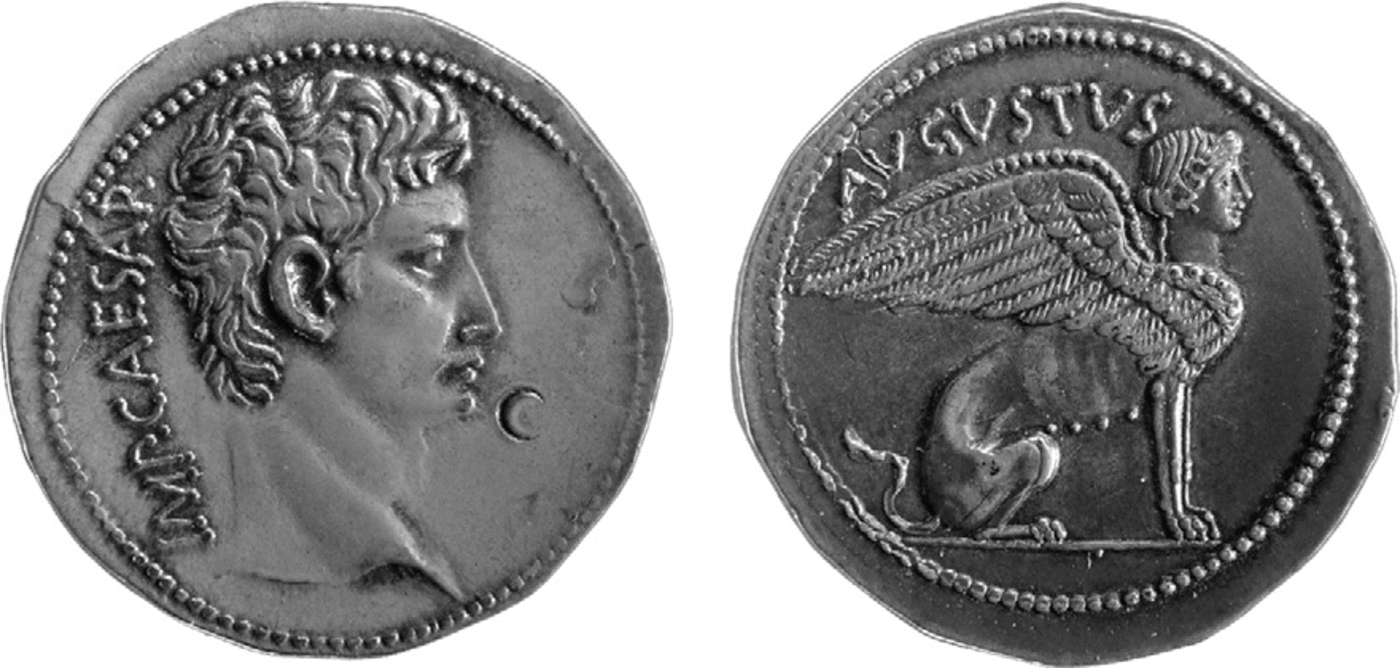
Figure 5. Silver Cistophorous minted in Asia under Augustus, ca. 27 BCE. London, The British Musuem (AN31814001). © The Trustees of the British Museum.
At the very least, this aspect of the costume should be considered in relation to the fad for multi-breasted figures that swept bellifontain art in this period and reflected an interest in the ancient Mother Earth goddess, Artemis of Ephesus.Footnote 55 Connoting fertility, figures such as Niccolò Tribolo’s Nature (1528) and Primaticcio’s term of Ceres in his study for the decorations of Fontainebleau’s Chambre du Roi (ca. 1535–36) were used, as Rebecca Zorach has argued, to stress France’s natural wealth and the king’s role in sustaining that superabundance.Footnote 56 Similar figures are equally present in Primaticcio’s Masquerade of Persepolis (fig. 6), which reflects a lost fresco for the Fontainebleau quarters of the king’s mistress, Anne de Pisseleu, Duchesse d’Etampes (1508–80).Footnote 57 The scene corresponds to the moment prior to the burning of the palace at Persepolis, an act of retribution against Xerxes sanctioned by Alexander the Great and described by various authors, including Plutarch and Diodorus Siculus.Footnote 58 Permeated by the eerie glow of torchlight and a strange, sensual atmosphere, the drawing includes among its costumed revelers two individuals representing the city of Epheseus, who descend the palace’s staircase while garbed in temple headdresses and polymastic cuirasses in honor of Artemis. Similar costumes may perhaps have been used in masquerades hosted by the court: as noted earlier, the multi-breasted figure motif appears in the helmet of the Hymenaeus costume worn by Henri and his companions.Footnote 59

Figure 6. Francesco Primaticcio. The Masquerade of Persepolis, ca. 1541–44. Pen and black ink, gray wash, heightened with white. Paris, Musée du Louvre, Département des arts graphiques (INV8568-recto). Photo: Adrien Didierjean. © RMN-Grand Palais / Art Resource, NY.
The costume’s polymastic dimension was thus a key signifier of nurturing abundance and was also tied to Roman imperial imagery. The sphinx itself was subject to diverse interpretations in the Renaissance.Footnote 60 At the negative end of the spectrum, the creature was seen to signify ignorance brought about by pleasure-seeking, shallowness, and pride, as in Andrea Alciato’s Emblemata, the first French translation of which was executed by Jean Lefevre and appeared in 1536. Featured in emblem 188, “Submovendam ignorantiam” (“That ignorance must be banished”), Alciato’s sphinx, however, is “in its face a virgin / in its feathers a bird / in its feet a lion.”Footnote 61 The corresponding illustrations in the various editions of the text that appeared between 1531 and 1577 stressed the beast’s ornithological characteristics, often replacing its hindpaws with talons.Footnote 62 Given that the costume designed by Primaticcio possessed no such avian features, and in light of the exalted identities of its wearers, the outfit was surely not meant to evoke ignorance, the very affliction François sought to eradicate through various means, including the foundation of the College of France in 1530.
The sphinx was also understood as a symbol of vigilance: this association is evoked, for instance, in Raphael’s Council of the Gods in the Villa Farnesina’s Logge di Psyche (1516–17), where a female-headed sphinx wearing the nemes headdress is placed beneath Janus, knower of both past and future.Footnote 63 For humanists such as Pico della Mirandola, whose writings had a lasting impact in France, the creature was emblematic of the concept of knowledge as a secret that requires initiation.Footnote 64 An important source for this notion was Plutarch, who wrote of the Egyptians’ wisdom being “hidden for the most part in myths and stories which show dim reflections and insights of the truth, just as they of course suggest themselves when they place sphinxes oppositely before the shrines, intimating that their teaching about the gods holds a mysterious wisdom.”Footnote 65 In addition to delighting the audience with its bejeweled exoticism, the sphinx costume may have been meant to communicate the concept of vigilance — a highly desirable trait in a ruler — as well as the idea of François Ier as a guardian of secret knowledge. The king enjoyed occupying this position in real life, as attested by the complex programs he commissioned, most famously for the Galerie François Ier, and by the relationship he entertained to his art. The images’ lack of transparency was calculated to sustain François’s role as the metaphoric key to unlocking the Galerie’s structural and iconographic mysteries.
That the king relished being the custodian of the program’s significance and controlling to whom it was divulged is evidenced by his reserving the space for his own use and his keeping the key to the Galerie on his person.Footnote 66 Marguerite de Navarre (1492–1549) confirmed this aspect of her brother’s personality when she declared to him: “Seeing your edifices without you is like watching a dead body, and looking at your buildings without hearing your intentions for them is like reading Hebrew.”Footnote 67 Situated on the western side of the Galerie’s southern wall — and thus seen by sixteenth-century visitors at the conclusion of their visit — Rosso Fiorentino’s Ignorance Put to Flight (fig. 7) also evoked the idea of the king as both the gateway to, and the gatekeeper of, knowledge.Footnote 68 Portrayed in the guise of a sword-brandishing Caesar, François is visually conflated with the portal to the temple of Jupiter that he is about to enter, thus simultaneously calling to mind his function as both a conduit and an obstacle to what lies inside. Only the king has access to the temple’s interior and can see the golden light of wisdom that spills forth from it, while the blindfolded figures in the foreground, still guided by Ignorance, futilely grope the air around them. Footnote 69 The Galerie’s program thus ended by drawing attention to François’s role in monitoring the dissemination of knowledge, the very task he undertook each time he explained the space’s significance to a visitor.
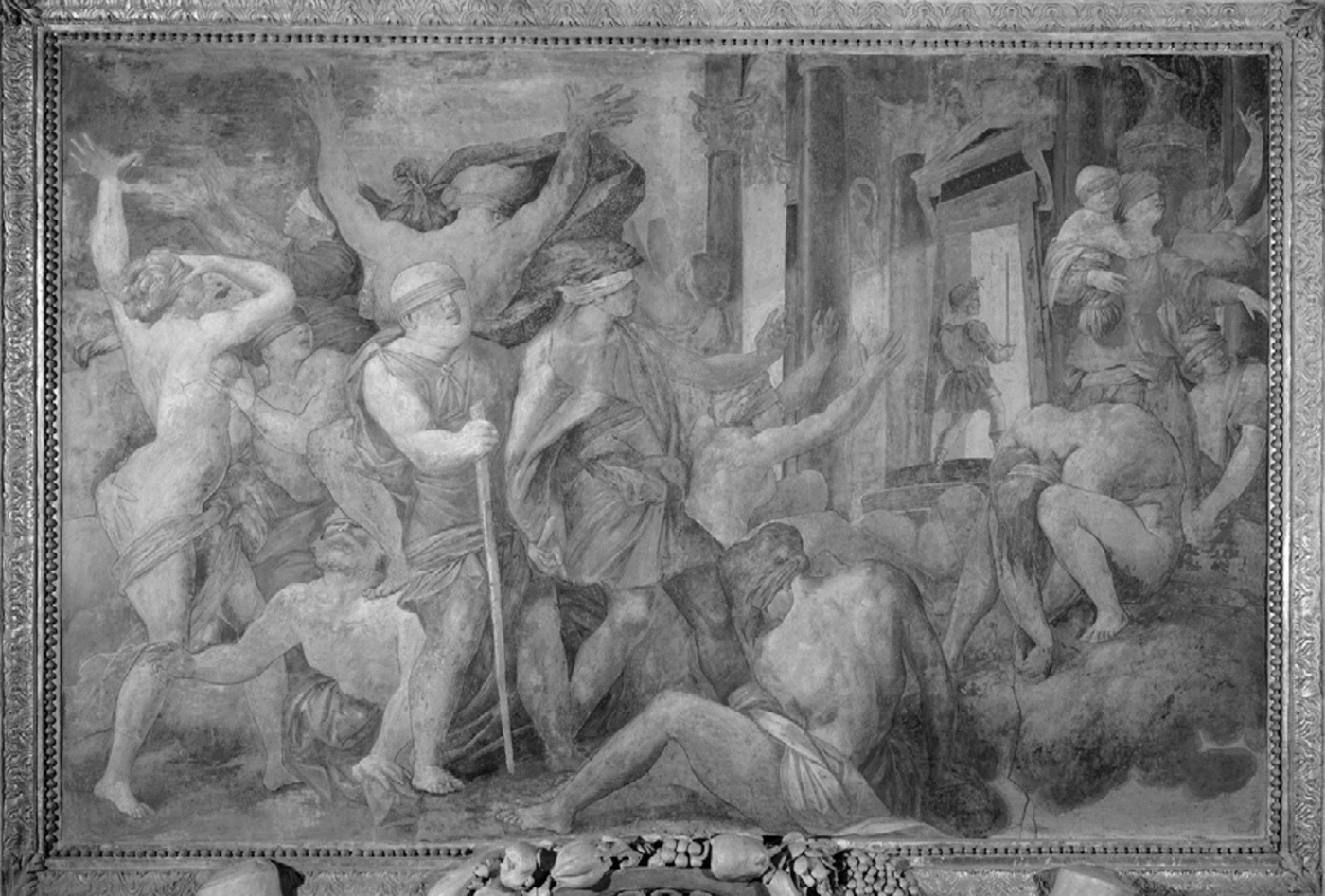
Figure 7. Rosso Fiorentino and assistants. Ignorance Put to Flight, ca. 1533–39. Fresco and stucco decoration. Château de Fontainebleau, Galerie François Ier. Photo: Peter Willi. © RMN-Grand Palais / Art Resource, NY.
5. The King’s Shadow: Jean de Lorraine
The idea of incarnating a sphinx may have appealed to François because of the creature’s association with the protection of knowledge. Jean de Lorraine’s appearance alongside the king in the same costume also begs interpretation. This act was likely intended to assert the cardinal’s status as someone privy to the knowledge guarded by the king and awarded the privilege of sharing in its guardianship. (It is also worth remembering that entrances to ancient Egyptian temples were understood to have been defended by pairs of sphinxes.) As Cedric Michon has shown in his study of Jean de Lorraine’s life, from the time he was first recorded at the French court in 1520 until François’s death in 1547, he benefitted from the king’s favor nearly constantly.Footnote 70 While the cardinal never possessed the political clout of the Constable of France, Anne de Montmorency (1493–1567),Footnote 71 he enjoyed an “unparalleled physical proximity” to the king, an honor he was able to maintain thanks to his adaptability.Footnote 72 Jean was, to use Michon’s expression, l’homme du roi (the king’s man), and his diverse duties included serving as François’s alter ego on at least one diplomatic mission.Footnote 73
This closeness found visual expression in different ways, including in Jean’s systematically appearing as the king’s disguised doppelgänger at masquerades.Footnote 74 Indeed, important relationships were clearly mapped out within the ostentatious context provided by these events: the cardinal’s position as François’s trusted mignon was advertised through their sharing of an alternate identity and its often fantastic sartorial accessories.Footnote 75
At a masquerade held on a Sunday evening during Carnival in 1542, François and Jean both danced in the guise of bears.Footnote 76 They sported gem-studded collars and muzzles made of gold in which precious jewels were incrusted, including “the diamond that his Majesty purchased the previous year for sixty-two thousand scudi” and the “egg of Naples,” presumably the same 241-carat ruby that would later be listed in the inventory of Mary Stuart’s jewels following the death of her husband, François II (1544–60).Footnote 77 This masquerade thus provided Jean with an opportunity to bedeck himself with prized royal gemstones, and in doing so to conspicuously promote his status as François’s favori.
Light-catching jewels were not the only accessories integrated into the pair’s costumes. For a masquerade held in honor of the wedding of the Duke of Maine in August of 1546, the king and the cardinal dressed as hermits covered in foliage, fruits, and vegetables, with the dictum sat cito si sat bene (“it is done soon enough, if it is done well enough”) appearing amid this vegetation.Footnote 78 The presence of these words, which are linked to the Augustan adage festina lente (“make haste slowly”), as Erasmus reminds his readers, reveals that in this instance, François and Jean’s costumes possessed a very clear emblematic function.Footnote 79 The saying sat cito si sat bene proclaims the importance of doing things properly rather than too quickly, for in Erasmus’s words, “ripening brings sweetness in its own good time.”Footnote 80 The proverb’s relationship to ripened vegetation would later be made explicit in emblem 5, “Subrepunt prospera fata” (“Happiness arrives slowly”), of Imbert d’Anlezy’s Liber Fortunae (1568), which was illustrated by Jean Cousin le Fils (ca. 1522–94). Footnote 81 On the recto facing the emblem proper, which shows Fortune on top of a turtle, the motto “it is done soon enough, if it is done well enough” is integrated into a frame featuring cornucopias brimming with grain and fruit (left and right sides, respectively), an ox (upper edge), and houses (lower edge). The meaning of this arrangement is explained in the accompanying text, which states that all great honors come slowly, “and step by step in the way that the ox slowly makes the wheat come, [as well as] grapes, apples, and pears, and constructs houses and palaces such as those in the border of the compartment.”Footnote 82 Through their bountiful vegetal elements, François and Jean de Lorraine’s hermit costumes were doubtlessly also intended to bring to life the motto’s connection to the reaping of natural abundance and would have advertised the necessity of proceeding carefully and unhurriedly, a highly desirable inclination, particularly in a ruler.Footnote 83
At Shrovetide 1541, the king and the cardinal transformed themselves into trees for a masquerade held at Fontainebleau.Footnote 84 They wore gowns that simulated the appearance of bark and covered their heads and hands with ivy. Writing to the Duke of Ferrara on 6 February 1541, Carlo Sacrati remarked that François and Jean’s tree costumes were “interpreted as being imprese that conformed to the motto that was written on the overgowns [of the knights].”Footnote 85 The knights in question wore colorful silk embellished with a design of broken columns and ruins as well as a border with the following epigram: qualis Roma fuit, ispa ruina docet (“what Rome was, its ruins teach us”). According to Sacrati, then, the king and the cardinal’s attire served to inform this conceit: the pair thus presumably incarnated not just any vegetation, but rather the kind that sprouts from Roman ruins as it appears in many illustrations, such as the frontispiece to Serlio’s Third Book of Architecture, which features the same epigram.Footnote 86 Even a costume representing something as seemingly mundane as a tree could be vested with lofty meaning: in this case, it evoked the rebirth of classical ideals and the king’s role in promoting this phenomenon, particularly at Fontainebleau, which Vasari later qualified as a “New Rome.”Footnote 87
It would doubtlessly be imprudent to dismiss as mere flights of fancy François and Jean’s crustacean costumes, which were discussed by Lodovico da Thiene in the same letter to the Duke of Ferrara that described the wedding of Jeanne de Vivonne de la Châtaigneraie and Claude de Clermont as well as other festivities.Footnote 88 Defined as “gambari” (most likely crayfish or spiny lobsters), the costumes were made of red satin and were adorned with gold fringes and cords “at every joint and at every nodule that a crayfish may have.”Footnote 89 Crustaceans were rich in symbolic significance: the crab (or crayfish) was associated with the astrological sign of Cancer and was an attribute of the planet Jupiter as well as of Diana of Ephesus, and was also featured on Augustan coins alongside the butterfly to illustrate the motto festina lente.Footnote 90 François and Jean’s costumes may somehow have been connected to these concepts, or perhaps the key to their meaning lies in Horapollo’s Hieroglyphica, in which the spiny lobster is specifically associated with the act of ruling. The text explains that when the Egyptians want to communicate the idea of “a man ruling over his fellow citizens, they draw a spiny lobster and an octopus. For the spiny lobster rules over the octopuses and holds first place among them.”Footnote 91 While the intended message of this particular costume may never be elucidated, it is clear that whether appearing as denizens of the sea or living vegetation, François and Jean were frequent partners in disguise, whose remarkable costumes awed audiences and publicized French royal refinement as well as the pair’s special bond.Footnote 92
Primaticcio’s sphinx was thus one of a string of sophisticated and at times eccentric costumes worn by the king and the cardinal. Transformed into this formidable creature of the East, François and his shadow, Jean de Lorraine, became the embodiment of all of its mysteries. How accessible the costume’s layers of meanings would have been to its audience requires consideration. While it is impossible to know exactly what witnesses thought of it, Alvarotti’s letter to Ercole d’Este offers interesting information on the subject. The diplomat concludes his description by writing, “What exactly the name of this costume is I leave it to your Excellency to determine,” and then, “some baptize it faun, others satyr” — a statement he attempted to erase, presumably because he realized these were unsatisfactory interpretations.Footnote 93 That the costume was not easily recognizable to an Italian diplomat or to his secretary does not mean, however, that it was not invested with significance, even with multiple layers of meaning.
In fact, much thought clearly went into the elaboration of complex symbolism for masquerade costumes that typically produced baffled reactions. Thus, at a mommerie organized at Châtellerault five years earlier, François and the cardinal once again appeared together, this time dressed entirely in gold and each holding in one hand a lightning bolt and in the other, a shield, to the utter mystification of those whose impressions were recorded.Footnote 94 For a masquerade held in 1518 in the Bastille’s courtyard as part of a banquet honoring the ratification of the Treaty of London,Footnote 95 François presented himself in a white satin robe “in the manner of Christ” embroidered with golden compasses and clocks, symbols used elsewhere to advertise the king’s prudence and temperance.Footnote 96 According to Marino Sanudo, the objects elicited diverse interpretations among those in attendance, reminding us that like so much of the art commissioned by the king, masquerade costumes were often not meant to be instantly understood by all, but rather to be deciphered by those in the know.Footnote 97
6. Horapollo’s Hieroglyphica as a Source for Primaticcio’s Costume Studies
Several extant costume studies by Primaticcio appear to have been designed for this purpose, including an example enhanced with delicate shades of yellow, green, and pink watercolor now in Stockholm’s Nationalmuseum (fig. 2).Footnote 98 The drawing shows a masked man wearing an antique-style outfit comprising a cuirass-like component with articulated musculature and pteruges.Footnote 99 He supports a curtained baldachin on which rests a lamp between two disembodied heads. In formulating this creation, Primaticcio relied on De la signification des notes hiéroglyphiques des Aegyptiens, the first printed French translation of Horapollo’s Hieroglyphica, which was published in Paris by Jacques Kerver in 1543 (fig. 8).Footnote 100 This was also the first printed edition of the text to have illustrations, 197 woodcuts traditionally attributed to Jean Cousin le Père.Footnote 101 The angled heads featured in Primaticcio’s costume design closely correspond to those of the hieroglyph for a phylactery, in the sense of a safeguard or a charm, in Kerver’s edition. The definition beneath the image explains that the Egyptians signified a protective force by representing a male head looking in and a female one looking out. The inscription in Primaticcio’s hand at the bottom of the costume study translates to “all defense, security, and preservation of life.”Footnote 102 The same phrase, minus the word “life,” appears in the hieroglyph’s explanation as it is given in Kerver’s 1543 edition.Footnote 103 Moreover, ten extra hieroglyphs first make their appearance in De la signification des notes hiéroglyphiques, including one signifying “life,” which is represented by none other than a burning lamp (a concept taken from the Hypnerotomachia Poliphili) (fig. 9).Footnote 104
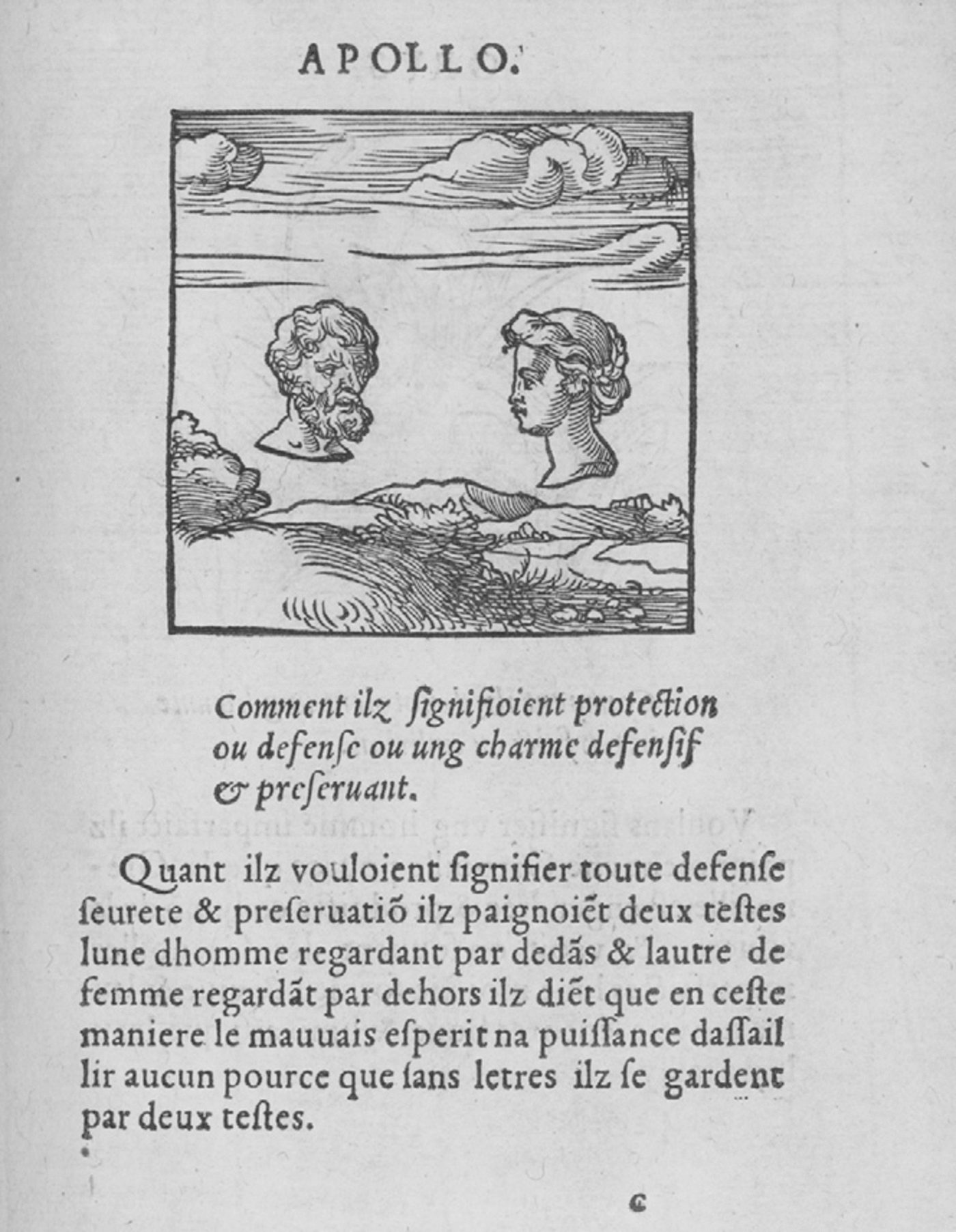
Figure 8. “Comment ilz signifioient protection ou defense ou ung charme defensive & preservant,” fol. cr from Horapollo, De la signification des notes hiéroglyphiques des Aegyptiens (Paris: Jacques Kerver, 1543). New York, The Metropolitan Museum of Art, Rogers Fund, 1921 (21.24.2). © The Metropolitan Museum of Art.

Figure 9. “Comment ilz signifioient la vie,” from Horapollo, De la signification des notes hiéroglyphiques des Aegyptiens (Paris: Jacques Kerver, 1543). Woodcut. New York, The Metropolitan Museum of Art, Rogers Fund, 1921 (21.24.2). © The Metropolitan Museum of Art.
In devising this costume, Primaticcio was creating a statement by combining hieroglyphs derived from the 1543 French edition of the text, and making them his own through slight modifications that demonstrated his mastery, such as changing the position of the heads. The burning lamp nestled between angled male and female heads was meant to convey the concept of protection and the preservation of life. If the individual carrying these glyphs was to be understood as the source of this protection, then it is likely that the role would have been reserved for someone important, such as the king. At the very least, given that the costumed figure is holding the curtains open, one can assume that the person incarnating him in real life was meant to be seen at some point during the masquerade. Presumably, this masker’s appearance at a ball would have prompted audience members to try their hand at reading his costume, and in successfully doing so, to demonstrate their familiarity with Horapollo’s text.
It remains uncertain whether the masker would have divulged the meaning of his attire to his audience. In the same letter describing the dauphin’s Hymenaeus costume and the king and the cardinal’s crustacean outfits, Lodovico da Thiene explains what François Ier’s youngest son, the Duke of Orléans, Charles d’Angoulême, wished to convey when he appeared at a masquerade as a young woman spinning thread while seated on a fake turtle with a head that peeked in and out of its carapace as it advanced.Footnote 105 Primaticcio’s study for this remarkable costume is preserved in Stockholm (fig. 10).Footnote 106 According to the ambassador, Charles’s intention was to communicate that while he went about his business slowly, he did not waste a moment of his time, just like the turtle moving at a sluggish pace nevertheless covers much ground, and the thread that takes a long day of spinning to obtain is nonetheless the same thread that dresses the entire world.Footnote 107 Tied yet again to the motto festina lente, the costume’s significance may have been divulged to the Italian diplomat by the duke himself or by someone close to him.
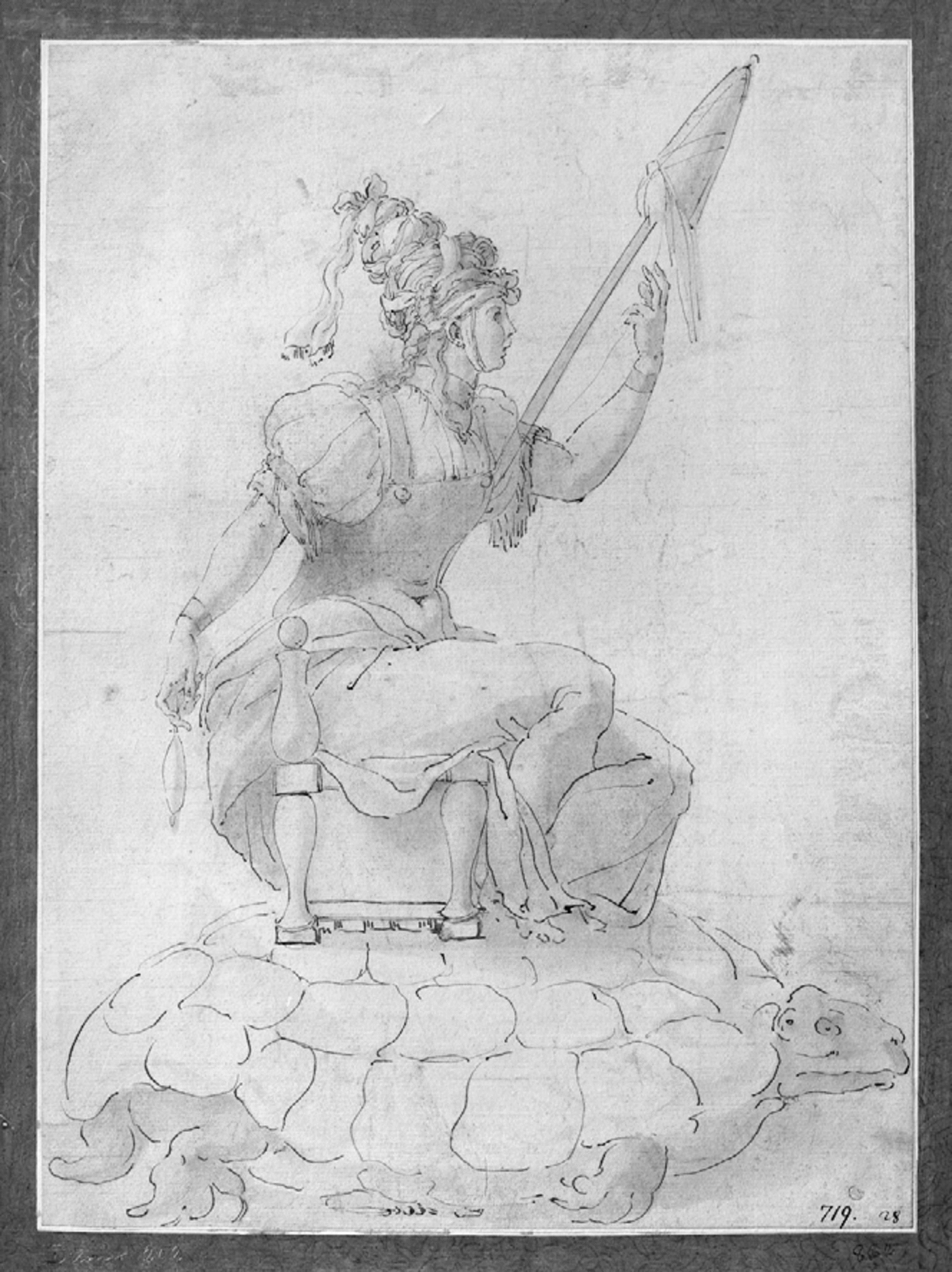
Figure 10. Francesco Primaticcio. Study for an Allegorical Costume Representing Steady and Productive Slowness, ca. 1542. Pen and brown ink, gray wash, watercolor. Stockholm, Nationalmuseum (862/1863). © Nationalmuseum, Stockholm.
Knowledge of De la signification des notes hiéroglyphiques would have been equally necessary for deciphering the costume envisioned by Primaticcio in a related drawing now in Florence’s Biblioteca Nazionale Centrale (fig. 3).Footnote 108 This design is connected to another hieroglyph from Kerver’s 1543 edition, which shows a landscape with a man eating an hourglass while dressed in contemporary garb (fig. 11). The explanatory text reveals that the Egyptians portrayed the horoscopist in this manner “not because a man can really eat the hours, which is impossible, but rather because men prepare their meats and what they must eat at certain hours.”Footnote 109 The theme of the horoscopist would certainly have appealed to the French court, since it entertained in this period an intense fascination with astrology, of which Egypt was regarded as the birthplace.Footnote 110 In keeping with its quasi-theatrical function, Primaticcio’s horoscopist costume, which comprises a pseudo-classical tunic, a mask-shaped clasp, and an extravagant plumed hat, is far more exotic than the attire worn by the figure in the woodcut. The drawing’s connection to Kerver’s 1543 edition is firmly established, however, through Primaticcio’s notation beneath the figure, which translates to, “Horoscopist monitors the hours to assess things.”Footnote 111 The inscription is in fact an abbreviation of a passage from the horoscopist’s definition: “a horoscopist, that is to say, who charts and monitors the hours to assess the state of things.”Footnote 112 It remains uncertain whether Primaticcio’s inscription would somehow have been part of the performance, or whether it was merely meant as an explanatory title for the benefit of his patron or those responsible for executing the design. At the very least, judging from the artist’s drawing, the masker would likely have simulated the consumption of an hourglass while appearing before spectators, which would have been the key clue to determining his identity.
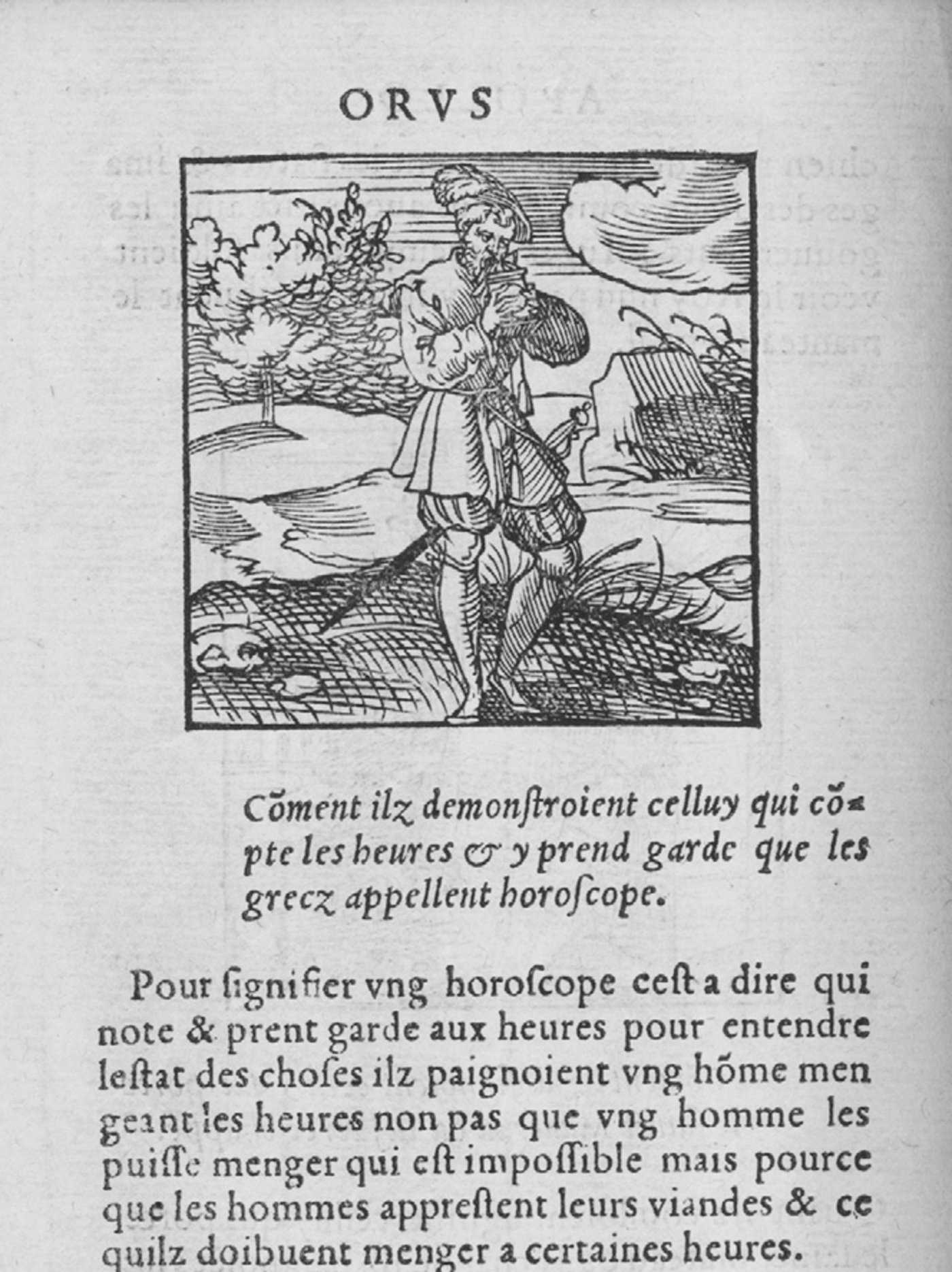
Figure 11. “Comment ilz demonstroient celluy qui co[m]pte les heures & y prend garde que les grecz appellant horoscope,” fol. diiv from Horapollo, De la signification des notes hiéroglyphiques des Aegyptiens (Paris: Jacques Kerver, 1543). Woodcut. New York, The Metropolitan Museum of Art, Rogers Fund, 1921 (21.24.2). © The Metropolitan Museum of Art.
In light of the their relationship to De la signification des notes hiéroglyphiques, The Defense and Preservation of Life (fig. 2) and Horoscopist (fig. 3) may have been designed sometime relatively close to the text’s publication, that is, during the last years of François Ier’s reign, when the book would have had added appeal due to its novelty. Writing in the early 1970s, Claude Massenet and William McAllister Johnson argued that the drawings were executed later, in the period between 1563 and 1570.Footnote 113 Massenet outlined the reasoning behind this dating in his short response to J. T. D. Hall’s notice in The Burlington Magazine on three previously unpublished letters written by Primaticcio to Catherine de’Medici (1519–89) and to Renée de France, Duchess of Ferrara (1510–74).Footnote 114 After remarking that the only drawings bearing inscriptions by the artist in French are the ones that concern us here, Massenet asserted that they are “both in his late handwriting,” which he defined as not “irregular, but clear, sharp, precise, and even, with light and varied pressure on the pen.”Footnote 115 However, these characteristics may just as easily be explained by Primaticcio’s not having spontaneously written his thoughts, but rather his having copied from a foreign-language text, which would have required from him a greater degree of application. Moreover, there is ample proof that Primaticcio’s activity as a costume designer was in full swing by the 1540s, and not limited to the last decade of his life, as Louis Dimier had first suggested over a century ago.Footnote 116
7. The Royal Language of Hieroglyphs
Primaticcio’s Defense and Preservation of Life (fig. 2) and Horoscopist (fig. 3) reflect the French court’s interest in what was certainly one of the most intriguing remnants of Egyptian culture to have reached it: hieroglyphic writing. In his dedicatory preface to Louise de Savoie, the anonymous author of MS 682 asserted that “those who will know this book [the Hieroglyphica] will be able to write through figures the gestures of kings in marble and in tapestry.”Footnote 117 Early on in François Ier’s reign, then, Horapollo’s text was presented to the royal family as the key to accessing hieroglyphs, which were ideally suited to communicating in cryptic fashion the deeds and ambitions of contemporary rulers. Primaticcio’s Defense and Preservation of Life and Horoscopist reveal that, in addition to two-dimensional and sculptural art forms, Horapollo’s text was also used as a basis for “writing through figures” in the medium of masquerade costumes.
What made this writing so palatable to the noble audience that appropriated it was its enigmatic character. Renaissance thinkers believed that the Egyptians embedded their most important knowledge in hieroglyphs as a way of keeping it beyond the reach of all but a select, initiated few.Footnote 118 The preface to De la signification des notes hiéroglyphiques reminded French readers of this fact, stating that: “saintly and divine things have never been common nor public but only entrusted and given to certain wise and discreet individuals; also we see commonly and it always happens that things that are too known and too obvious lose their reverence and authority and in the end become subject to contempt and disdain.”Footnote 119 This fascination with hieroglyphs reflected a broader preoccupation with veiled truths that also fueled interest in alchemy and the teachings of the Kabbalah, which were grounded in the belief that another level of meaning was hidden beneath the literal text of scripture and that decoding these secrets was the key to accessing the divine. Designed to transform their wearers into living signs that required special knowledge to be deciphered, Primaticcio’s two costume studies based on De la signification des notes hiéroglyphiques were thus very much in accordance with the esoterically inclined climate that flourished during François Ier’s reign. At the very least, such costumes should be considered in relation to the royal taste for enigmas, anagrams, and other brainteasers, such as the portrait game, which invited participants to try their hand at deducing the identity of a sitter in a drawing after the inscription bearing his or her name and motto had been obscured.Footnote 120 Of course, identification within this context was really a process of recognition, and thus a means of reaffirming appurtenance to the court. The same may be said of Primaticcio’s Defense and Preservation of Life and Horoscopist: interpreting these costumes meant proving familiarity with Horapollo’s text and thus with the learned, elite language of hieroglyphs.
8. Conclusion
This profound fascination with veiled knowledge helps to explain why Egyptian-themed costumes and other obscure creations enjoyed currency within the context of French masquerades, particularly under François Ier, who often positioned himself as a keeper of secrets as a means of exercising control. Murky references could contribute to creating an effective power dynamic based on separating those in the know from those who were not, such as foreign visitors, who might be dazzled but perplexed, and consequently made to feel impressed by the French court’s sophistication. As Primaticcio’s sphinx (fig. 1) and Hieroglyphica-inspired costumes (figs. 2–3) suggest, ancient Egypt offered the ruling elite what the familiar pantheon of Greco-Roman characters might not: the ability to mystify, and through this, to cultivate superiority.
As the sixteenth century progressed, Egypt continued to play a role in masquerades and other forms of costumed entertainments. Participants in these events often had occasion to dress as people from foreign countries, who thus collectively became representative of the vast world over which their monarch’s sovereignty extended. The theme of the Other was also prevalent in these contexts because it offered an opportunity to showcase unusual and striking costumes that amazed the eye and triggered the imagination.Footnote 121 For the Carnival period in 1583, for example, the royal accounts of Henri III (1551–89) mention silver cloth for the fashioning of coats in the exotic “Egyptian style” to be worn at masquerades.Footnote 122 Foreignness could also be exploited for its comic potential, particularly if it was combined with cross-dressing. Thus, Brantôme notes that at a tilting at the ring tournament organized by François II (1544–60) at Amboise, the Grand Prior François de Lorraine (1534–63), appeared in the guise of an Egyptian woman to the great amusement of his audience.Footnote 123 An impression of his outfit may perhaps be gleaned from François Desprez’s Recueil de la diversité des habits (fig. 12), which provides an often critical (and fanciful) record of the clothing habits and customs of different nationalities and professions. In addition to toting a monkey dressed as a child, François de Lorraine wore a large round hat as well as “a gown and cotte of velvet and very puffy taffeta,” calling to mind the Recueil’s illustration of an Egyptian woman, who is portrayed carrying a real infant.Footnote 124 The idea of Egypt as a land of continuity is evoked in the accompanying quatrain, which insists that the Egyptian woman wears her garments according to ancient tradition, an implicit criticism of French sartorial fickleness in this period.Footnote 125 Thus Egypt was not only used within court-sponsored spectacles in its capacity as the birthplace of impenetrable mysteries, but also as an alien land of unfamiliar conventions with a quaint attachment to the past.
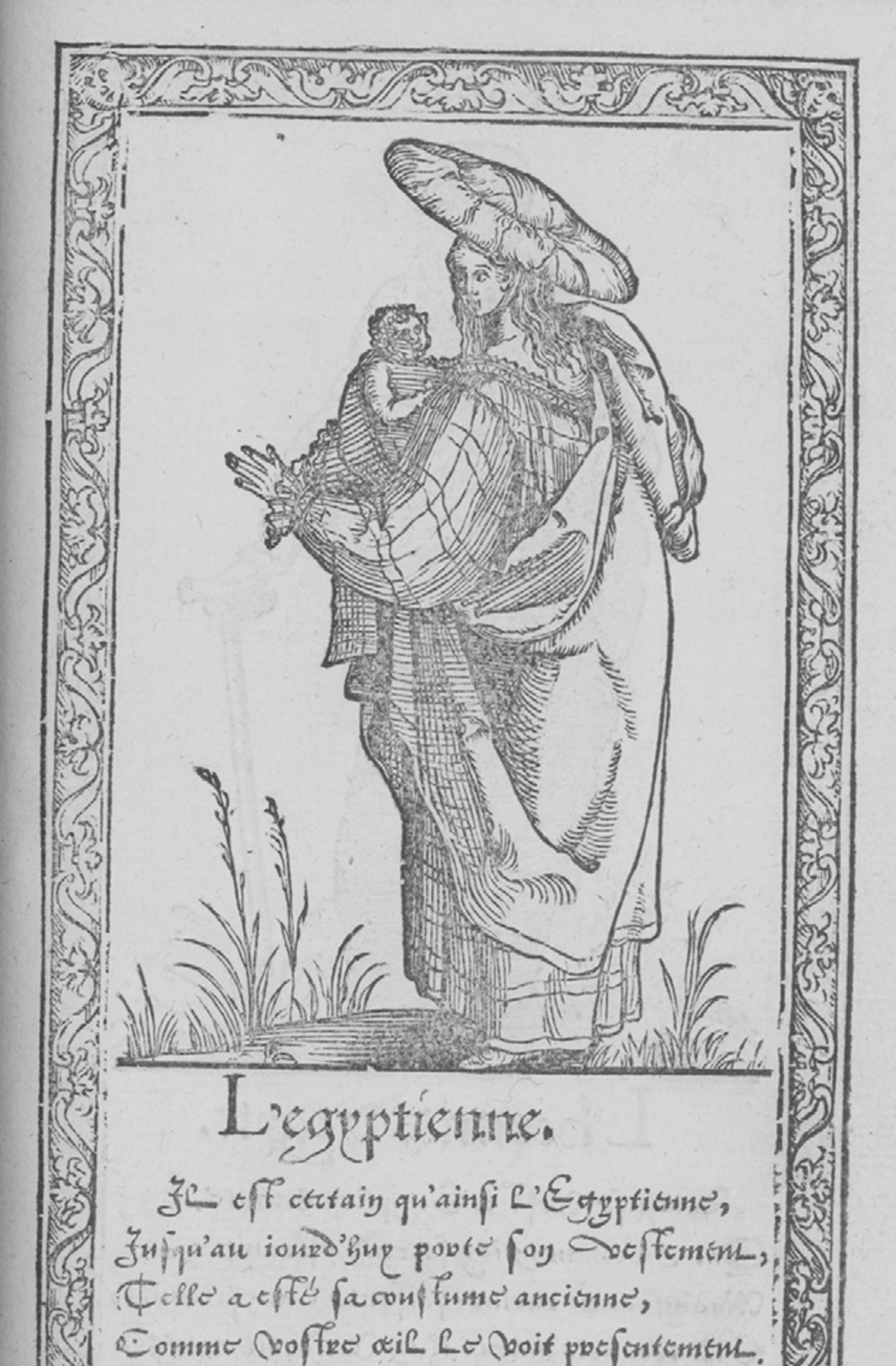
Figure 12. “L’egyptienne,” fol. G6 from François Desprez, Recueil de la diversité des habits (Paris: Richard Breton, 1562). Woodcut. New York, The Metropolitan Museum of Art, Harris Brisbane Dick Fund, 1940 (40.129). © The Metropolitan Museum of Art.
As for the Hieroglyphica, its importance to European festivities in the Renaissance and early Baroque periods merits a systematic study.Footnote 126 Horapollo’s text and Piero Valeriano’s expanded commentary on it (Basel, 1556) constituted key sources for events such as the masked Genealogy of the Gods procession organized in Florence for the marriage of Francesco de’ Medici to Joanna of Austria in 1565.Footnote 127 In addition to the familiar cast of mythological characters described by Boccaccio, the procession comprised abstruse embodiments of concepts like Persuasion (Peithò), for which an anonymous costume study survives.Footnote 128 Persuasion took the form of a matron wearing a headdress with a bloody eye (from which sprouted a tongue) and holding another eye attached to a hand, because, as Baccio Baldini observed in his description of the event: “the Egyptians as we read it in Horus in the first book of his Hieroglyphica, when they wanted to signify speech that persuades to the point of provoking action, they showed it by these two signs.”Footnote 129 Several other quotations from Horapollo’s and Valeriano’s texts were incorporated into this mascherata, including the anemones worn by the personification of illness or palm leaves held by the incarnation of month. In the following century in England, Ben Jonson was influenced by these publications in the formulation of his theatrical productions, such as the Masque of Blacknesse (1605), and even went so far as to refer to masques as “Court-hieroglyphics” in his Expostulation with Inigo Jones (1631).Footnote 130 Further investigation into these texts’ usage in these contexts would surely yield important insight into how the sacred secrecy and exoticism of ancient Egypt was appropriated by the European elite as part of its quest to centralize its power and distance itself from the common realm. Additional research will also hopefully make it possible to connect Primaticcio’s Defense and Preservation of Life (fig. 2) and Horoscopist (fig. 3) to a particular event, and in doing so, to learn more about their functions and the French royal culture to which they belonged.














